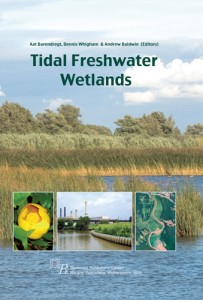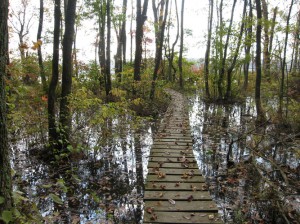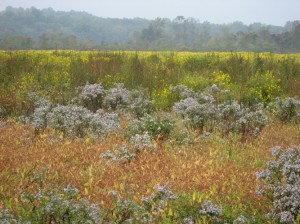
Tidal Freshwater Wetlands
Whigham, along with colleagues Aat Barendregt from Utrecht University and Andy Baldwin from the University of Maryland, has edited the new book Tidal Freshwater Wetlands. It’s a weighty work containing more than 20 chapters written by more than 40 authors. For the first time ever, they have systematically peeled back the layers of these overlooked coastal ecosystems. The book explores how these wetlands work, the animal and plant life they support, and the threats they face.
Tidal freshwater wetlands are pretty well described by their name. You’ll find them near the mouths of rivers that flow into estuaries like the Chesapeake Bay. Whigham’s book focuses on the ones found in North America and Europe. Perhaps the best studied of these wetlands is Maryland’s Jug Bay. Here – as in all these wetlands – the tides essentially force the Patuxent River to flow backwards twice a day. What separates Jug Bay from its saltwater marsh brethren is a lack of…salt.

Maryland's Jug Bay Wetlands at high tide. The Patuxent River provides the freshwater, the Chesapeake Bay offers up the tides. Photo by Dennis Whigham.
They might be more famous – and studied – if tidal freshwater wetlands could lay claim to particular plants and animals. They can’t. From the perennial green arrow arum to mammals like muskrats, the life that these wetlands support can be found in other ecosystems. No matter. What these wetlands lack in unique residents, they make up for in diversity.
Tidal freshwater wetland plants are as productive as the most productive agricultural crops. They generate enough leaves, seeds and rhizomes to feed a range of insects, birds and fish. These wetland plant communities also earn their keep by improving water quality. During rainstorms they filter runoff before it enters the estuary.
The ebb and flow of the tide creates a dynamic environment that’s in constant flux. Spend a day in a place like Jug Bay and you’ll likely see the birds change with the tide. When the water’s high, terns and osprey can plunge in and out of the water, nabbing their prey. At low tide, lanky-legged herons and long-toed rails meander the mudflats searching for food.
Tidal Freshwater Wetlands describes the wildlife in these ecosystems and also explores the daily and seasonal cycles of the plants. Plants are Whigham’s area of expertise. When he walks through a marsh, he notes the subtle changes in gradient. Among other things, gradient affects hydrology, flooding and oxygen levels.

The fall colors in Maryland's Jug Bay reveal the rich plant diversity found in tidal freshwater wetlands. Photo by A. Baldwin.
It’s difficult for many seeds to germinate in the anoxic low-lying regions of these marshes. Whigham and his colleagues have found that the higher areas of tidal freshwater wetlands support a greater variety of plants.
Some of the wetland plants have even evolved features that help them make it to the higher, more aerobic, marshland. Peltandra virginica, for example, bears fruit that contains buoyant seeds. A layer of mucilage engulfs the seeds and helps them float – with the tide – to slightly higher ground.
People don’t escape the lens of Whigham’s book either. It includes amusing historical footnotes (moonshiners hid their stills in these marshes during Prohibition) and important trends. Humans have harnessed and used tidal freshwater wetlands throughout history, especially in Europe. We’ve turned these wetlands into everything from rice fields to metropolises. Washington, D.C., Philadelphia and most major port cities in northwest Europe developed on these types of marshes.
For the tidal freshwater wetlands that have survived human pressures, a new one looms. Throughout the book, Whigham and the authors remind readers that these unique coastal ecosystems are on the frontlines of global climate change and rising sea levels. This could cause brackish water to migrate upstream and into the freshwater zone. An increase in salinity could make these wetlands inhospitable to some of the plants and animals that call them home.
A sense of urgency underpins much of Tidal Freshwater Wetlands. Each chapter bubbles forth with new questions to research. There’s a sense that scientists have only just begun to understand the role and function of these ecosystems. And with the climate-change clock ticking, they want to urge others to run – quickly – into these wetlands. Just check the tide charts, wear your waders and bring some repellent.
Return to SERC’s home page.


Does the separation of fresh water from salt water take place in nature?